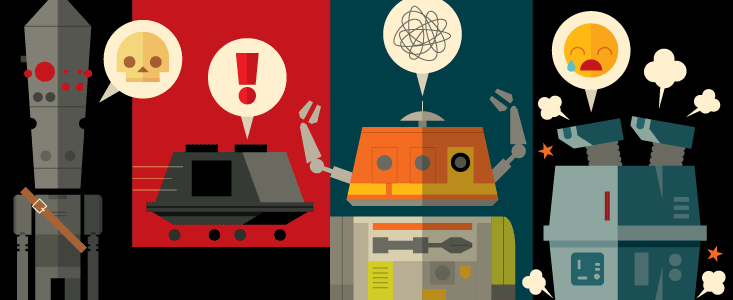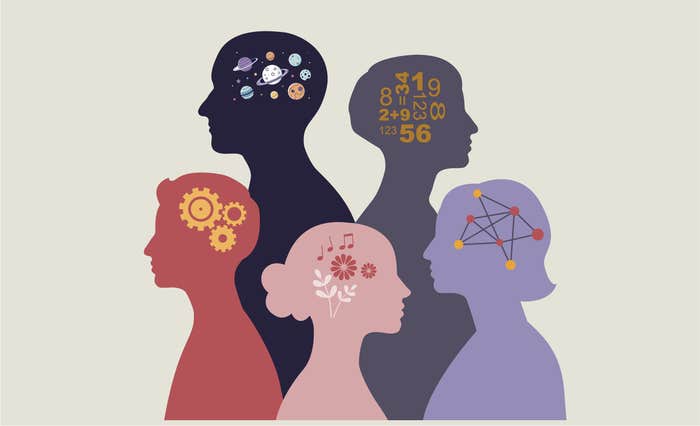I am your father.” The iconic line from Star Wars, in which Luke Skywalker discovers the real identity of Darth Vader, marks the point in the series when two polar opposites that had been cleanly divided—the Jedi and the Dark Side—are suddenly mixed together in the most personal of ways.
This ambiguity of opposition, which is part of what makes the series so compelling, is well known. There is another example of this opposition, though, that is easier to overlook: Star Wars both humanizes machines, so that we can like them, and dehumanizes them, so we can accept their slaughter.
By the conclusion of the series, we feel a genuine warmth for the droid characters, R2-D2, C-3PO, and BB-8 and a concern for their safety. But why, when we know they are just machines?

Part of the answer is that R2-D2, BB-8, and C-3PO certainly act as though they have a wide range of feelings. C-3PO, in particular, expresses sadness, happiness, and a lot of worry and stress. In the novelization of Star Wars: Episode VII The Force Awakens, droid BB-8 is described as being “very concerned,” and at other times actually depressed. This makes it easier for us to emotionally attach to them.
What’s more, droids in the Star Wars universe also seem to feel suffering and pain. Battle droids cry out when they are killed, and a dismembered C-3P0 berates Chewbacca when he accidentally knocks his head while carrying the droid on his back.
Anakin and Luke can also speak “binary,” the language of the droids, giving them a window onto the experience of their robotic companions. The viewer is also exposed to the affection of fictional human characters for the droids. They watch Anakin display great care for and loyalty to R2-D2. A generation later, Luke is dismayed in Dagobah when he loses R2-D2 in the swamps. Then Chewbacca searches for C-3PO so he can put him back together. Rey refuses to sell BB-8 to get food. Some characters obviously care about droids. Shouldn’t we care, too?
Our reaction to droids and machines derives from the fact that our minds have roughly two functioning parts—the old brain and the new brain.
The back of the head and the top of the spinal cord is where our old brain resides. It’s largely shared with other mammals, and specializes in behaviors and responses that evolved long before we were human. It is a large part of what we call intuition. The new brain, near the front of the head, is more deliberate and slow. This is why the fear we feel when watching a horror movie is only partially attenuated by telling ourselves “It’s just a movie.” Our old brain reacts the same way it would if the events were actually happening in front of us.
We are challenged to accept machines as living, feeling beings when they are “good guys,” and then to dismiss them as senseless automatons when they are not.
The divide between old brain and new brain lets us literally be of two minds about droids. We recognize them as just machines, but emotionally invest in them. This division can be seen in our reactions to computers and software. Social psychology experiments have shown that people respond to a spell-checker much as they do to an actual person. Some people are even starting to get attached to their Roomba robotic vacuum cleaners, according to a 2007 report from the Georgia Institute of Technology.
At the same time, we see legions of robot soldiers in Star Wars being killed without blinking an eyelid. In the Clone Wars, the Separatist Army is made up almost entirely of droids. Here is the other side of the droid dichotomy in Star Wars. We are challenged to accept machines like R2 as living, feeling beings when they are “good guys,” and then to dismiss them as senseless automatons when they are not.

The good guys have a war to fight. Audiences would likely find it disturbing to see Jedi heroes killing humans (or other living aliens) with the frequency we see in the Clone Wars. Though battle droids occasionally exhibit worry and fear, we never really get to know any of them as characters, making their deaths that much more acceptable. When the Republic destroys enemy droids, our emotional response is one of joy or even humor, not the horror of killing. The death of machines—hordes of machines—that we don’t care about is fine with us.
The ambiguity of our relationship with droids in Star Wars is amplified by their physical appearance. There are few droids in the Star Wars universe (and none in the films) indistinguishable from living creatures, unlike some androids in other franchises, like the replicants of Blade Runner and the androids of the Alien franchise. When the alien Queen tears the android Bishop in half, viewers emotionally react as if they were witnessing a human getting murdered.
What’s more, Star Wars droids are effectively masked. Masking a character dehumanizes him or her, interfering with our capacity for empathy. We have trouble reading facial expression from even partially-covered faces. It’s easy to miss suffering if it’s not visible. So it is for droids, who have rudimentary facial expressions at best.
This physical unfamiliarity lets us have our emotional distance when we need it, and our closeness when we want it. The Star Wars stories are so compelling, in part, because its creatures—be they human, alien, or droid—are identified as people, at least in how they think and act. However strange they might look, droids are always psychologically humanoid. But Lucas never lets them quite get there. In Star Wars, we are within reach of both humanized and of dehumanized droids, two sides of the same coin, a bit like the Force itself.
Jim Davies is an associate professor at the Institute of Cognitive Science at Carleton University in Ottawa, where he is director of the Science of Imagination Laboratory.


























